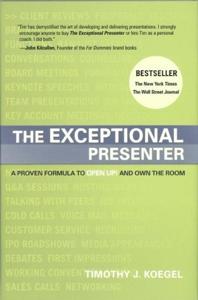
Want to learn the ideas in The Exceptional Presenter better than ever? Read the world’s #1 book summary of The Exceptional Presenter by Timothy J. Koegel here.
Read a brief 1-Page Summary or watch video summaries curated by our expert team. Note: this book guide is not affiliated with or endorsed by the publisher or author, and we always encourage you to purchase and read the full book.
Video Summaries of The Exceptional Presenter
We’ve scoured the Internet for the very best videos on The Exceptional Presenter, from high-quality videos summaries to interviews or commentary by Timothy J. Koegel.
1-Page Summary of The Exceptional Presenter
Today’s Virtual World
Virtual meetings and presentations are becoming increasingly popular because of the following reasons:
People see virtual meetings as cost-effective, efficient and practical. Virtual meetings include training, teaching, account reviews, sales calls, client reviews and board meetings. As technology advances more of your future communications will be virtual.
If your presentation is not relevant, people won’t pay attention to it. Your message, purpose, topic and agenda must be compelling. If you don’t engage the audience quickly, they will tune out. Ask them to commit their attention for 25 minutes in exchange for 3 strategies that will help them generate opportunities with existing clients.
Ask the audience to turn off their cell phones. Make your presentation more interactive by calling on individuals in the crowd for input. Ask a question and wait until someone responds, even if it takes a long time. Your audience will understand that they must participate in order for you to continue with your speech. Open strong, using humor, visuals, video or sound effects and music to get people interested right away. Tell stories; they help bring your message alive. Use visual props as well.
Practice makes perfect. The more you practice, the better you’ll get at delivering your ideas to others. Sit comfortably in front of a camera and speak clearly into it. Avoid fidgeting with your hands and maintain direct eye contact with the camera lens.
Watch the clock to make sure you don’t go over your time. Don’t use verbal graffiti, such as “you know”, “like” and “uh”. Virtual meetings must be exceptional presentations that seamlessly transition between stories, film clips, audio clips and background music. Technology can enhance a presentation but it’s what you say that matters most.
Learn from TV and Radio Broadcasters
Presenting virtually is not easy. It’s tough to connect with your audience, and it gets even tougher when people start looking at their phones or computers while you’re speaking. You have to be aware of the challenges that virtual presenters face, and there are many similarities between presenting virtually and broadcasting on radio or television. So learn from those experiences so that you can overcome them in virtual presentations.
Broadcast professionals do not interact with their audience. They make no eye contact, and they assume that people multitask while watching or listening to them. However, most of these presenters are excellent at what they do in a virtual environment. Watch and listen carefully to how announcers handle transitions between segments.
Planning is important in effective communication. Broadcasters use a rundown, which is an outline of the broadcast’s timing and flow. Use sequencing charts as your outlines to plan virtual presentations. A sequencing chart has five columns: time, topic, talent or presenter(s), tools and transitions between speakers/topics/tools. Fill in these columns with detailed information for each section as appropriate.
“The goal is to create a presentation atmosphere that appears as close as possible to a face-to-face meeting.” To do so, prepare an outline for your virtual presentation and include working information, time for questions and answers, and the resources you must develop in advance. Prepare guidelines detailing what role each person on your virtual team will play. Like broadcasters, follow the “most interesting first” rule by beginning with the most engaging information; answer five important questions:
- What are the most important topics? What order should I present them in?






